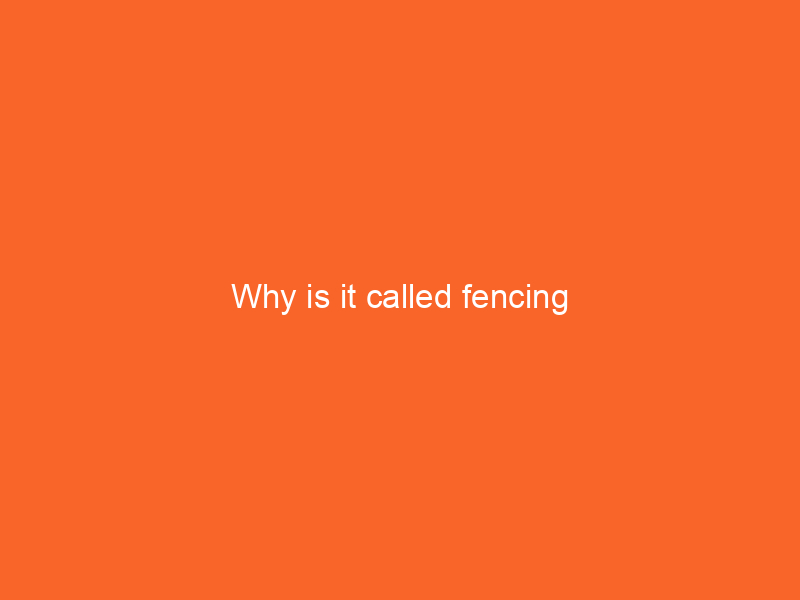The Intriguing Origins of the Term “Fencing”
When you hear “fencing,” you might conjure images of swift swordplay, duelling with foils, épées, and sabres. Yet, if you were to conduct a quick online search, you’d likely stumble upon results related to outdoor enclosures and fences, which seemingly have nothing in common with the graceful art of sword fighting. It’s a peculiar coincidence that these two vastly different concepts share the same name.
Many seasoned fencers may not know the fascinating history behind “fencing.” To understand why the sport of fencing is called just that, we need to embark on a linguistic journey back in time.
Why Not Simply “Sword Fighting”?
At first glance, you might wonder why the sport isn’t simply called “sword fighting.” The reason lies in the historical context of fencing education. Early fencing schools expanded beyond the art of wielding swords. They offered comprehensive training in various combat techniques, including shields, daggers, pikes, spears, and, in later years, firearms. The term “sword fighting” couldn’t encompass this broader spectrum of martial training.
Fencing, as we know it today, traces its roots to the original European schools of fence, with one of the most renowned being based in Spain. Between 1458 and 1471, Diego de Valera penned the “Treatise on Arms,” one of the oldest texts on fencing. This seminal work covered an array of weapons, marking the official birth of fencing as both an art and a science.
In today’s context, “sword fighting” is an umbrella term that encompasses various styles, making it too broad and imprecise to describe modern sport. If you mentioned attending a “sword fighting class” during lunch, it could evoke thoughts of wielding broadswords in service to King Arthur, mastering the way of the samurai, or even training to become a Jedi with a lightsaber.
Investigating the roots of the term “fencing” reveals an intriguing linguistic trip. The name “fencing” derives from the Latin term “defence,” which means “protection.” Transitioning into Old French, it became “defens,” retaining its essence of safeguarding. By the 15th century, English abbreviated it to “fens,” adding another layer of complexity to its linguistic evolution.
Initially known as “schools of defence,” these institutions eventually adopted the name “schools of fencing” as the intricate rules and practices of fencing became standardized. In essence, “fencing” became synonymous with the art of defence.
Interestingly, this linguistic connection needs to be more consistent across languages. French uses “escrime,” derived from “escremie,” meaning “combat.” Italian employs “scherma,” linked to “skirmen” and “skirmish,” denoting protection, shielding, or covering. Spanish shares its roots with Italian and French through “esgrima.” German utilizes “fechten,” tracing its origins to “fehtan,” meaning fight. Greek boasts an array of words related to fighting and swordplay. Japanese incorporates “kenjutsu,” where “ken” signifies sword and “jutsu” represents art or craftsmanship. Chinese features “jijian,” where “ji” translates to hit, and “jian” represents sword, dagger, or sabre. Korean adapts “pensing,” combining “pen” (pen) and a sound effect, “zoom.” Hebrew uses “saif,” indicating ending or finishing. Arabic opts for “mubāraza,” connoting fight or duel, intertwined with words for hero and champion. Russian employs “fextovánije,” derived from the German term “fechten,” referring to sport fencing. Even American Sign Language lacks an official sign for fencing but typically involves spelling the word “fencing” while miming a parry and thrust motion.
In fencing, practitioners from diverse linguistic backgrounds come together, united by their passion for discipline, self-improvement, and camaraderie. While the language may have many interpretations of the word “fencing,” one undeniable truth prevails – the global love for the sport of fencing knows no linguistic bounds.
Where did fencing originate from?
Fencing, with its elegant and precise movements, traces its origins back to ancient times, embedding itself in the annals of human history. While the exact pinpoint of its inception is challenging due to its extensive and multifaceted history, fencing, as a formalized practice, found its early roots in Europe. Swordsmanship and duelling were prevalent among ancient civilizations like the Egyptians, Greeks, and Romans. However, it was during the European Renaissance that fencing transformed into a refined art form. The Italian and Spanish fencing schools emerged as influential pioneers, shaping the techniques and etiquette of this martial art.
What is the meaning behind fencing?
Beyond its physical manoeuvres and competitive spirit, fencing embodies a profound symbolic significance. At its core, fencing represents more than just the clash of blades; it mirrors life’s intricate dance between offence and defence, strategy and spontaneity. It’s a metaphor for the battles we face daily, not only on the fencing strip but in the challenges of our lives. The term “fencing” resonates with the art of protection, echoing its Latin origin, “defence.” In this context, fencing transcends the sports arena; it becomes a metaphor for safeguarding one’s beliefs, values, and dreams amidst life’s adversities. Like the careful parries and strikes on the strip, life demands strategic thinking, adaptability, and swift decision-making. Fencing, thus, stands as a profound allegory, teaching us resilience, discipline, and the art of defending what truly matters.
What is a male fencer called?
A male swordsman is known colloquially as a “fencer.” Fencing, an activity steeped in history and refinement, has no gender distinction in its terminology. Fencing is a phrase that encompasses both male and female practitioners. Because players are recognized and commended only for their ability, love, and understanding of the art rather than their sexual orientation, this inclusivity illustrates the sport’s commitment to equality. The term “fencer” refers to people of all ages and genders who gather together under the banner of this elegant and strategic sport.
Which country is known for fencing?
France is renowned as a powerhouse in the world of fencing. The country has a rich history and tradition in this elegant sport, consistently producing exceptional fencers who excel internationally. French fencers are celebrated for their finesse, precision, and strategic brilliance, making France a dominant force in various fencing disciplines such as épée, foil, and sabre. The French fencing culture emphasizes discipline, dedication, and technical mastery, which are instilled in athletes from a young age. This legacy has earned France a distinguished reputation in the global fencing community, making it a country well-known and respected for its contributions to the sport.

